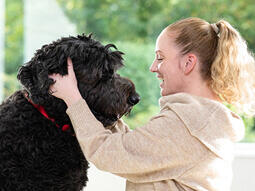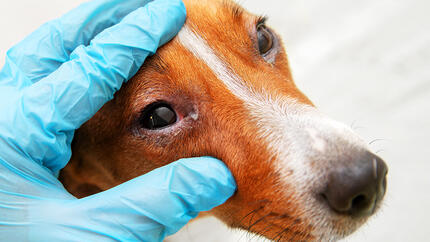
If you’ve spotted that your dog has weepy eyes, it’s likely you’re wondering what the possible causes are. Find out all you need to know about runny eyes in dogs and when to seek veterinary help in this guide.
Our dogs’ eyes are incredibly precious – they help our canine friends explore and discover the world. So, when we notice something slightly out of the ordinary such as our dog’s eyes watering, it’s only natural that we feel a sense of panic.
What causes weepy eyes in dogs?
Weepy or runny eyes in dogs is actually a fairly common problem and the causes of it can range from something as normal as wind or dirt getting in their eye to more serious health issues such as glaucoma in dogs. Some of the most common causes are:
- Dog eye infections
- Corneal ulcers
- Eye injuries
- Conjunctivitis in dogs
- Dry eye
- Eyelash issues
- Eyelid issues
- Wind exposure
- Eye lumps
- Something stuck in the eye
- Breed-related issues
What other symptoms of dog weepy eyes should I look out for?
Alongside your dog’s weepy eyes, you may see the following symptoms:
- Rubbing their eyes
- Squinting
- Holding their eyes closed
- Redness
- Swelling
- Cloudy eyes
If your dog has weepy eyes after a walk but the problem quickly clears up, then it may well have just been caused by a sharp wind or little bit of debris. If the weepiness lasts longer or you notice any of the symptoms listed above, seek advice from your vet.
Weepy eyes in dogs: what discharge colour means
One of the things you should look at if your dog has runny eyes is the colour of the discharge, as this will give you some clues as to the cause of the problem.
We’ve given a guide to some of the possible causes of eye discharge of different colours below, but bear in mind that these are just guidelines and sometimes the situation is more complicated. It’s always best to check with your vet to find out what’s going on.
If the discharge coming from your dog’s runny eye is clear, there are a range of possible causes. In many cases it will be dog allergies or a reaction to dust or wind. Clear discharge can also be due to blocked tear ducts, corneal wounds or eye abnormalities in certain breeds such as prominent eyes, hairs irritating the cornea or rolled-in eyelids. Alternatively, if the discharge is watery and just coming from one eye, it could be a sign of something more serious such as dog glaucoma.
When the discharge is clear, it’s also important to look at how much there is. If it’s only a small amount and the eye doesn’t look red or sore, there may be no need to worry, but it’s always safest to get advice from your vet if you’re in any doubt.
Red tear stains are usually seen on dogs with lighter coloured fur and they may look alarming, but don’t worry, the red colour is not due to blood. Tears turn red like this when they’re exposed to air, so the red/brown hue is just due to oxidisation.
Often, red/brown staining is a cosmetic issue in flatter faced breeds such as Pugs and French Bulldogs who have prominent eyes and tend to get a bit of tear overflow. However, sometimes tear staining can indicate a treatable eye problem causing excessive tear production or inadequate drainage. If in any doubt, check with your vet. To reduce tear staining, you can wipe the area with a damp cloth.
Yellow or green discharge is generally a cause of concern and your dog should be taken to the vets straight away for treatment.
The most common cause for yellow or green discharge is an eye infection. In this case your dog may show other signs of conjunctivitis such as eye redness, inflammation and soreness.
Sometimes an infection is the primary problem, but sometimes it can develop secondary to other conditions such as dry eye or an eye injury.
Whatever the cause of the yellow/green discharge, it is likely to require treatment, so it’s best to get your dog checked out by your vet.
If your dog’s weepy eye is slightly crusty or gloopy in the morning, this isn’t necessarily a cause for concern – it’s just like what we humans get when we wake up. This crust is a combination of dried tears, dust, oil and dead cells and you can wipe it away easily with a clean, damp cloth.
However, if your dog has more than a small amount of this discharge, or it recurs throughout the day, it may indicate an underlying problem. One cause of sticky or crusty discharge is dry eye, a condition in which dogs are unable to produce enough tears. This condition can be very sore and if left untreated your dog’s vision can deteriorate, so it’s worth a vet trip if you have any concerns.
Breeds with dog runny eye issues to be aware of
Unfortunately, some breeds are more prone to runny eyes in dogs, usually due to their genetics and how they look. The cause of the dog watery eyes is dependent on the breed.
Breeds with loose skin on their faces, like Beagles, Saint Bernard and Bloodhounds, are more likely to have watery eyes due to cherry eye – a condition where the glands in the eyelids fall from their position. They’re also prone to eyelids that roll outward which can cause some eye issues.
Brachycephalic dog breeds (i.e., breeds with flat faces, like Pugs, Pekingese and Boxers) have a high chance of getting weepy eyes because of their protruding eyes and shallower eye sockets; eye lids that don’t fully close; or a condition which causes eyelashes to grow inwards.
How is the cause of runny eyes in dogs diagnosed?
Your vet will carry out a full inspection to find the cause of your dog’s watery eyes. This will usually begin with a visual examination of the discharge and a review of the overall health of your dog’s eye. They may put some drops in to check the eye’s surface, or assess the tear production if they’ve got any concerns on this score.
It’s likely they’ll also ask about your dog’s overall health and behaviour to rule out other health issues too.
What are the treatment options for weepy dog eyes?
You may also be given other dog eye drops or ointment as necessary. If you need to give anything topically, your vet will be able to show you how to apply it.
It’s important that you follow through with the full course of medication to treat your dog’s weepy eye, as if you stop the course early, there’s a risk that the issue won’t clear up properly or will return.
It's important to keep an eye out for any changes in your dogs eye health. Read our article on why your dogs eyes might be red or cherry eye, to understand the symptoms to look out for.
Now you know about weepy eyes in dogs and the potential causes! Looking for more information on the symptoms you should look out for? Check out our guide on ear problems in dogs, next.















